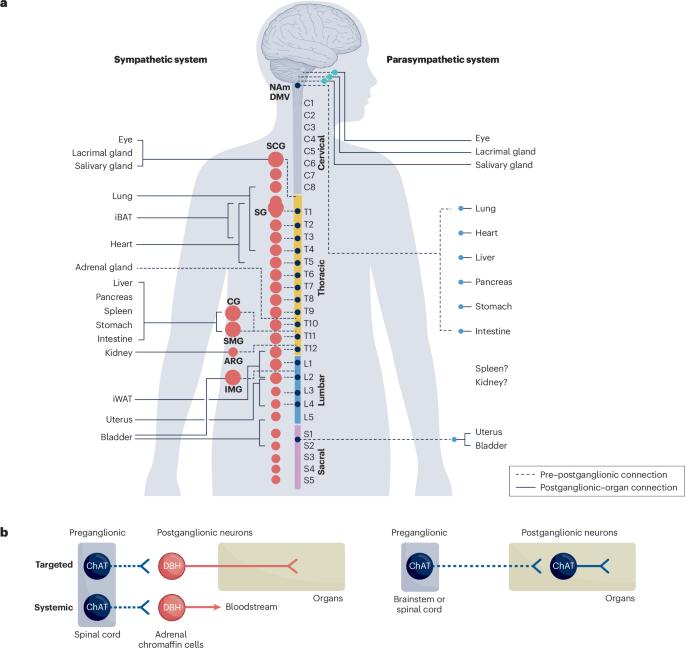Molecular and functional diversity of the autonomic nervous system
IF 26.7
1区 医学
Q1 NEUROSCIENCES
引用次数: 0
Abstract
The autonomic nervous system (ANS) plays a pivotal role in regulating organ functions through descending brain-to-body signalling. The pathways involved are broadly categorized into two major branches: the sympathetic nervous system, which mediates ‘fight or flight’ responses, and the parasympathetic nervous system, which governs ‘rest and digest’ functions. Historically, the ANS was considered to mediate simple motor functions with limited neurochemical diversity. However, recent advances in neurotechnology have shown that brain-to-body communication is more complex and dynamic than previously appreciated. This review synthesizes current knowledge about the molecular, anatomical and functional diversity of autonomic motor neurons. Here we present a comparative analysis of the cellular architecture of the ANS and the suggested roles of distinct neuron populations. Additionally, we explore the emerging view that the ANS interacts with diverse systems involving metabolism, immunology and ageing, which extends its role beyond simple brain–organ modulation. Finally, we emphasize the need for cell-type-specific and longitudinal studies of the ANS to uncover novel mechanisms underlying body–brain interactions and to identify new translational opportunities for therapeutic interventions. The autonomic nervous system has long been viewed as a simple motor system in brain-to-body signalling. In this review, Wang and colleagues highlight diversity within autonomic neurons and their dynamic roles across physiological systems and disease contexts.


自主神经系统的分子和功能多样性
自主神经系统(autonomic nervous system, ANS)通过下行脑-体信号在调节器官功能中起着关键作用。所涉及的通路大致可分为两大分支:负责调节“战斗或逃跑”反应的交感神经系统,以及负责控制“休息和消化”功能的副交感神经系统。历史上,ANS被认为介导简单的运动功能,神经化学多样性有限。然而,神经技术的最新进展表明,脑与身体的交流比以前所认识到的更为复杂和动态。本文综述了目前关于自主运动神经元的分子、解剖和功能多样性的研究进展。在这里,我们提出了ANS的细胞结构和不同神经元群体的建议作用的比较分析。此外,我们探索了一种新兴的观点,即ANS与代谢、免疫和衰老等多种系统相互作用,其作用超出了简单的脑器官调节。最后,我们强调需要对ANS进行细胞类型特异性和纵向研究,以揭示身体-大脑相互作用的新机制,并为治疗干预确定新的转化机会。
本文章由计算机程序翻译,如有差异,请以英文原文为准。
求助全文
约1分钟内获得全文
求助全文
来源期刊

Nature Reviews Neuroscience
NEUROSCIENCES-
自引率
0.60%
发文量
104
期刊介绍:
Nature Reviews Neuroscience is a multidisciplinary journal that covers various fields within neuroscience, aiming to offer a comprehensive understanding of the structure and function of the central nervous system. Advances in molecular, developmental, and cognitive neuroscience, facilitated by powerful experimental techniques and theoretical approaches, have made enduring neurobiological questions more accessible. Nature Reviews Neuroscience serves as a reliable and accessible resource, addressing the breadth and depth of modern neuroscience. It acts as an authoritative and engaging reference for scientists interested in all aspects of neuroscience.
 求助内容:
求助内容: 应助结果提醒方式:
应助结果提醒方式:


